Solar FREAKIN’ Cell Phones
What: This is a challenge to run your cell phone from off-grid solar!
Who: You and anybody else who’s interested in, advocates or talks about green energy and the environment.
Where: Wherever you are!
When: Do it now!
Why: You’ll learn about what solar is (and isn’t). You’ll be modelling good behavior (not just talking about solar).
Your cell phone will be independent of the grid. Even during a power outage you’ll have your cell phone up and running! Cell towers have battery and other backup so you’ll still be online!
You’ll understand solar better. Your argument for solar will be hardened and you’ll have more credibility.
You’ll be automatically promoting green drinks Ottawa since you’ll be bragging about your solar phone at dinner parties.
You’ll be cooler.
I rolled this challenge out to the Green Drinks community on January 12th, 2017. We had 15 people sign up to the challenge!
List of Adopters:
Darcy Whyte
Steve Aplin
Paul Cairns blog
Concept
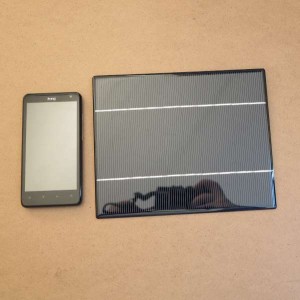 This is a fun challenge since it’s actually something you can do.
This is a fun challenge since it’s actually something you can do.
First of all you’ll need a solar panel. Most cell phones use USB which is a 5V technology. So theoretically you can charge your phone directly with one of these panels. You will need a panel that is big enough to supply whatever current your cell phone needs when charging. You can install an app on many cell phones which will tell you the amperage of your phone charging and use. You just need to make sure your panel is above the requirement and also that you’re in an area that has enough sun time to charge your particular phone.
There will be some people who can use one of these 5V panels as a solution because they sleep during the day (so their phone can charge during the sunlight) and they can then use their phone at night. A quick ebay search reveals some options.
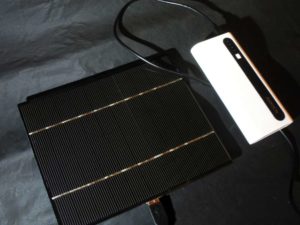 For the rest of us we’ll need to charge a storage battery using solar while we are out using our phone during the day. Then we can transfer the power from the battery to the phone at night when we’re resting. There are battery backups that can be used for this. I just did a quick search on ebay for “cell phone charger” and found many options. As you can see there are many other words to search for (Battery Bank, External Battery, Portable External Power).
For the rest of us we’ll need to charge a storage battery using solar while we are out using our phone during the day. Then we can transfer the power from the battery to the phone at night when we’re resting. There are battery backups that can be used for this. I just did a quick search on ebay for “cell phone charger” and found many options. As you can see there are many other words to search for (Battery Bank, External Battery, Portable External Power).
Before buying anything you’ll want to research to make sure the parts you’re buying have enough capacity to work with your phone and your environment.
For complete bragging rights you’ll want to make sure your solution can get you through several days of overcast or rain. If you have to charge your phone from the grid at some point then it’s not a solar phone it’s just a solar toy/novelty. I’d suggest you need to be able to run for months at a time without plugging your cell phone in.
For a more serious solution that could even run a laptop in a pinch you could consider a 12 Volt solution. The 12V angle is interesting because cars have 12V power so there are off the shelf parts to help you. You’ll need a 12V battery, suitable solar panel and charge controller to store your power. For charging you’ll need a cigarette lighter USB charger since it’s designed to connect to 12V and still supply your phone with the 5V it needs. Also you can purchase an invertor which can allow you to plug in any 120V item such as your laptop!
Case Study: Simple Panel With Battery for Storage
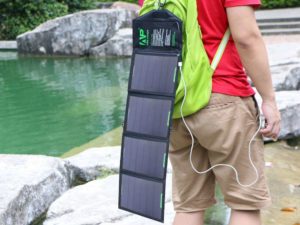
This is probably one of the better (and affordable approaches).
I got a solar panel for about 45.00US. It is designed for charging cell phones and battery backups and is rated at 5V, 18W.
This can charge the cell phone directly during the day if you’re not using your cell phone or you are in direct sun light.
The thing about a solar panel is it really needs sunlight. I say this because I have had solar advocates act with complete dismay when I tell them it will not work inside the pub at night (despite the fact that the lights are on). There are only a small number of hours during mid day when there is enough solar to do the job.
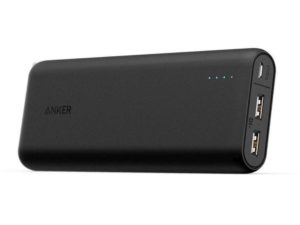 Also a descent cell phone battery backup. You can get all sorts of these. The ones I have were about 70US each and have lots of capacity.
Also a descent cell phone battery backup. You can get all sorts of these. The ones I have were about 70US each and have lots of capacity.
The idea is you use the solar panel to charge your battery backup during the day and then charge your phone from the battery backup during the night.
Also you could add more battery backups for convenience or capacity. For instance you could carry one with you and keep exchanging it with the one on the solar panel.
Case Study: Grid-be-Gone
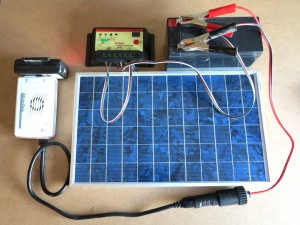 This practical solar cell phone charger uses the following components.
This practical solar cell phone charger uses the following components.
- Panel: 10W (34x20cm, 18 Volts, 0.6 Amps) $40-50
- Charge Control: 120W solar regulator (10A max, 12-24V w. monitor) $25
- Storage: 12V, 7Ah sealed lead acid battery $30-40
- Inverter: Typical with USB and 120V $30-40
- Assorted wiring and connectors.
- Around $150 total.
With this configuration you have a USB, a 120V outlet and a 12V outlet cigarette lighter type outlet. So you can even run your laptop in an emergency. Those with phones a bit finicky about generic USB chargers can just put their wall charger into the 120V socket.
In this picture it’s actually charging a phone battery.
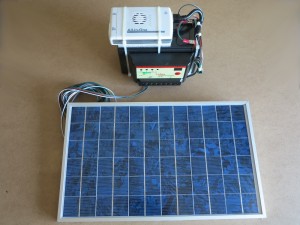 This has been working very well for some time now so I package it up so it can be toted around and be less of an octopus. I package everything (except 12v cigarette lighter).
This has been working very well for some time now so I package it up so it can be toted around and be less of an octopus. I package everything (except 12v cigarette lighter).
The panel has a long wire so you can put it on a window sill and then have the charger sitting anywhere near the window.
I’ve been running my cell phone (HTC Raider) and camera (Canon G1X) for some time now so this configuration really works. Preppers eat your heart out.
Solar Phone Charger Features
- Enough storage to survive a few days without sun.
- Solar panel on extension so charger can be close to window.
- 120V plug in
- USB plug in
- Can add a power bar
- Can add a USB hub
Future (or next version):
-Efficient boost converter to run laptop in emergency.
-Efficient buck converters to have many USB outlets.
-12V cigarette lighter outlet.
-Larger panel and battery to run laptop ongoing.
Here are some additional shots of different views and how I bundled it up.
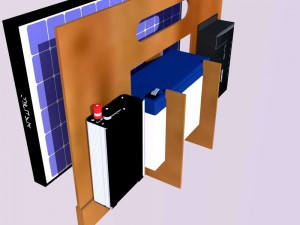 I ran the installation above with great success.
I ran the installation above with great success.
But it then went to Steve’s place and I think in his case there isn’t enough sun reaching his window so it didn’t work well. Plus it fell apart when he was transporting it. So I’m rebuilding it. I’m making a hardboard handle that holds the whole thing together and has a tray for the solar panel. The charge controller and inverter will be tie wrapped to the board using four holes each. The issues I’m working on now are:
- What will hold the battery cradle on the bottom.
- What is a cute way of being able to post the solar panel at different angles?
Project Economics
A typical cell phone is a small electricity user so it will be much less than a dollar per year to charge it off the grid.
This will not break even since a good solution will have batteries and they will need regular replacement.
Disclaimer
This is an experimental and educational project. You can void warranties break devices and start fires. So be careful and be sure to document and share what you do so you can get review and help from friends to make sure you don’t cause any damage.
How the Project Started
I keep seeing links in Twitter and elsewhere of cheap solar phone chargers. People think they’re being green by passing the link along (yes passing links along is what makes you green).
What really bothers me is it contributes to an already inflated expectation of solar power. Many people don’t realize the difficulty with storage of electricity. The electricity grid needs energy sources that that can supply on demand. Solar is only there for a certain period of the day so a solar-only system needs storage for most applications. Batteries work great in small applications but the situation is not pretty for large installations such as an electrical grid.
There are batteries but that’s really expensive. Even if the Tesla batteries become available at the advertised price it will be very expensive. Keep in mind that you need enough battery for a home to go several days (rain, overcast etc). And you need a large solar collector system to charge up to capacity quickly. Not like the current systems you see around based on FIT programming (they depend on an electrical grid that has power on demand).
Also it’s common for people to not be clear on how much power comes from a solar panel and under what circumstances. For instance I had some of those cheap panels from ebay and was talking to some people in a dimly lit pub a while back. They thought that just because the lights were on in the pub they’d be able to charge their phones off the panel. I had to correct them and explain that the solar panels need direct sunlight.
This education issue is so rampant that people pass this sort of video nonsense around.
There is so much wrong with the concept in the video. Without even getting to the issues of dirt, dust, grit and other things on the road, the concept just isn’t solid. The suggestion that a solar road could gather electricity to cook the snow off it is so far fetched. There are no batteries in the solar road so it’s just not going to deliver. And the amount of electricity wouldn’t be enough.
All this talk-talk-talk.
So what I’ve been doing when people bring up solar or tout it is challenge them to run their phone off solar. I can’t argue that they should be using it in their homes because they’ll feel they’re off the hook because they can’t control the Ontario power grid. But a phone is easy and nobody can stop you.
I’ve done a few solar phone experiments and the details the “Grid-be-Gone” which works very well are further down.
You can have a simple system without a battery if you only use your cell at night and can leave your phone on the charger during the day when the sun is shining. Also without a battery you need to be able to go without your cell in the event of a rain day or if there is cloud cover. If you can live with those restrictions you can get something going for 30-50 dollars.
Related
Published on: Jun 3, 2013 @ 15:22
Here’s a bike path with a solar panel canopy. They’ve figured out you need to drop the ridiculous idea of driving on the panels.


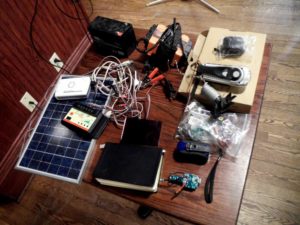




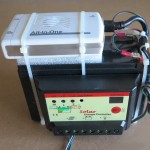


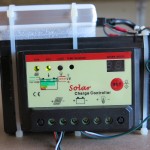
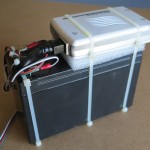
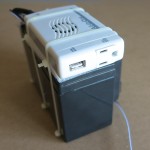


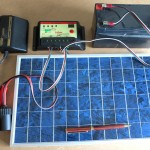
Thanks guys. This went to Stephen Aplin. So I’ll have to make another for myself. I have another one that doesn’t have a battery but that’s only good if I also have grid power available.
This is a really great idea!
Awesome!